 Just acquired, a fascinating and perhaps a hopeful document related to slavery. This is a bill of sale for a slave, but it is possibly a case of a husband buying his wife out of slavery.
Just acquired, a fascinating and perhaps a hopeful document related to slavery. This is a bill of sale for a slave, but it is possibly a case of a husband buying his wife out of slavery.
The first part reads, “Know All Men by these presents that I Catherine M. Folwell of Nashville, State of Tennessee, Widow, for and in consideration of the sum of Six Hundred Dollars to me in hand paid by Dow Johnson, now of Boston in the State of Massachusetts, the receipt whereof is hereby acknowledged, do hereby bargain and sell unto the said Dow Johnson, his executions & assigns forever a certain negro slave called Jane Johnson aged about 25 five years. And I, the said Mrs. Folwell do warrant the said negro to be a slave for life [the words: ‘to be sound, healthy, &’ have been crossed out] sensible, and warrant the title to said Dow Johnson, his heirs & assigns forever against all persons whatsoever. In witness whereof I do herein set my hand and seal this 23rd day of December A.D. 1852. Catherine M. Folwell. Witness: Ira Conwell and Jesse W. Page.”
It’s quite possible that this bill of sale was written by one of the witnesses, perhaps Conwell. On the second page is a lengthy endorsement by the Clerk of the County Court F.R. Chatham who attested to the validity of the bill of sale on January 31, 1853. Below this is the written endorsement of Phinehas Garrett County Registrar recording the bill of sale into the records of the County. One the third page is written, “This Bill of Sale is according to the Laws of Tennessee, and this negro woman Jane is to be delivered to Revd. Abiel Abbott [sic.] Livermore at Cincinnati, Ohio to be sent on to Boston, Massachusetts. Francis B. Fogg.”
Reading between the lines, it is possible that Dow Johnson remained in Boston and was most likely a freed slave (whether by purchase or escape is not known). However, he was prudent enough not to go to Tennessee on his own. Abiel Abbot Livermore was a Harvard-educated, New Hampshire native who became a Unitarian minister in 1836. He was editor of the Christian Inquirer, NY. He was called to the parish in Cincinnati in 1850 and no doubt had abolitionist leanings. Thus he helped arrange the purchase of and passage for Jane Johnson who was probably the wife of Dow Johnson. More research must be done on this document to prove or disprove these possibilities.
Comments Off on Free African-American buys his wife out of slavery?
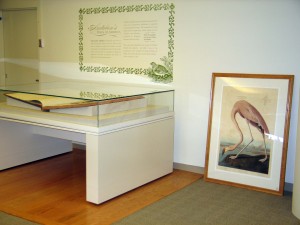 One of the first things I learned upon starting at the Watkinson was that our copy of the Birds of America, which was given to Trinity by one of its early graduates in 1900 (Dr. Gurdon Russell, Class of 1834), was incomplete. Unfortunately, well before the current security measures were put in place, a professional thief had stolen two plates from the book in 1977. One plate (no. 430, the Slender-billed Guillemot) was recovered from a Boston bookseller within a year of the theft—the man also stole from the Connecticut State Library, the Boston Public Library, the Peabody Institute, and the New Bedford Public Library in Massachusetts. The other plate (431, the American Flamingo), was never recovered. Fortunately, we were able to secure a copy of this plate (from another set, owned by a paper company in Alabama) at auction on September 28, so after 35 years, our set is complete again.
One of the first things I learned upon starting at the Watkinson was that our copy of the Birds of America, which was given to Trinity by one of its early graduates in 1900 (Dr. Gurdon Russell, Class of 1834), was incomplete. Unfortunately, well before the current security measures were put in place, a professional thief had stolen two plates from the book in 1977. One plate (no. 430, the Slender-billed Guillemot) was recovered from a Boston bookseller within a year of the theft—the man also stole from the Connecticut State Library, the Boston Public Library, the Peabody Institute, and the New Bedford Public Library in Massachusetts. The other plate (431, the American Flamingo), was never recovered. Fortunately, we were able to secure a copy of this plate (from another set, owned by a paper company in Alabama) at auction on September 28, so after 35 years, our set is complete again.
The fact remains, however, that somewhere out there, on someone’s wall (hopefully unbeknownst to them), is our copy of the Flamingo. Maybe someday we’ll find our wayward bird, but in the meantime, we will cherish our adopted one.
Tags: Exhibitions, natural history, New Acquisition, ornithology
Comments Off on Flamingo comes home!
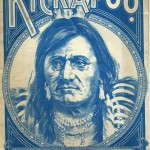 Recently acquired is a piece of ephemeral printing often associated with the traveling medicine shows. The Kickapoo Indian Medicine Company (headquartered in New Haven, Connecticut) published a variety of booklets and other advertisements to promote their products.
Recently acquired is a piece of ephemeral printing often associated with the traveling medicine shows. The Kickapoo Indian Medicine Company (headquartered in New Haven, Connecticut) published a variety of booklets and other advertisements to promote their products.
A great site which outlines the history of the company is here.
And here are some of the advertisements inside:

Tags: New Acquisition
Comments Off on The Kickapoo Doctor
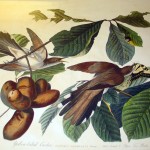 Actually, it’s the Yellow-billed Cuckoo–but in any case, the Audubon is now “in situ” and open to Volume I Plate II — ready for viewing! We will turn the page each Monday (or Tuesday, if Monday is a holiday) for the next 8.5 years and enjoy 433 new birds (Plate I, the turkey, was on display all summer, and so has done its duty; in fact, given the approach of Thanksgiving, we think it wants to keep a low profile).
Actually, it’s the Yellow-billed Cuckoo–but in any case, the Audubon is now “in situ” and open to Volume I Plate II — ready for viewing! We will turn the page each Monday (or Tuesday, if Monday is a holiday) for the next 8.5 years and enjoy 433 new birds (Plate I, the turkey, was on display all summer, and so has done its duty; in fact, given the approach of Thanksgiving, we think it wants to keep a low profile).
This plate (along with the other first five) was engraved by William Lizars in January 1827.
The choice of the first five plates was intentional, and the sequence was planned by Audubon during his tour of the Great Lakes in 1824. They included images of one large (turkey), one medium (Canada warbler) and three smaller species (yellow-billed cuckoos, purple finches, and prothonotary warblers).
Fifty copies were “struck off” for coloring, and Audubon was able to present the first set of five plates to the Royal Society of Edinburgh on February 5, 1827, with the venerable Sir Walter Scott in attendance. Audubon was scrambling to gather subscriptions to pay for the work.
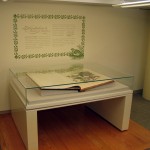 This exhibition is now open, but a more formal opening will be held on Thursday November 3rd. Prof. Christoph Irmscher from Indiana University (his faculty profile is here) will deliver a lecture entitled “How To Read Audubon.” Dr. Irmscher edited the Library of America edition of Audubon’s works, and writes on nineteenth-century American and Canadian literature, early American nature writing, and ecocriticism.From 4:00 – 5:00pm we will have all four volumes on display in the Reading Room, with Dr. Irmscher and myself on hand to answer questions. At 5:00pm professor Irmscher will deliver his talk in the Joslin Family 1823 Room, and we will hold a reception.
This exhibition is now open, but a more formal opening will be held on Thursday November 3rd. Prof. Christoph Irmscher from Indiana University (his faculty profile is here) will deliver a lecture entitled “How To Read Audubon.” Dr. Irmscher edited the Library of America edition of Audubon’s works, and writes on nineteenth-century American and Canadian literature, early American nature writing, and ecocriticism.From 4:00 – 5:00pm we will have all four volumes on display in the Reading Room, with Dr. Irmscher and myself on hand to answer questions. At 5:00pm professor Irmscher will deliver his talk in the Joslin Family 1823 Room, and we will hold a reception.
Tags: Exhibitions, ornithology
Comments Off on The Eagle Has Landed
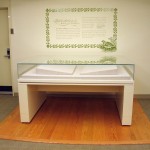 After almost a year (we began this journey last November), the permanent display area for our amazing set of John James Audubon’s Birds of America is finally complete.
After almost a year (we began this journey last November), the permanent display area for our amazing set of John James Audubon’s Birds of America is finally complete.
Next week, we will begin turning the pages (every Monday–or if it’s a holiday–Tuesday), and Trinity will get to see a new bird every week for the next 8 years or so. I will likely be blogging about some of the more well-known or quirky ones, but hopefully we’ll start to see some regulars coming in just to see the new bird! The turkey (plate I) was on display all summer, so we’ll give the poor fellow a rest (especially since Thanksgiving is around the corner). But here’s a pic of him (with a volume of the Library of America edition of Audubon’s works shown for scale):
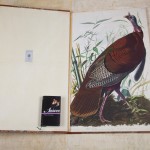 Mark your calendars for THURSDAY NOVEMBER 3rd, the official opening of this permanent exhibit. Dr. Christoph Irmscher, English professor at Indiana University and editor of the collection of Audubon’s works just mentioned, will be delivering a lecture on the production of the Birds of America over twenty years–it’s a grand tale indeed. There will be a “review” of the four volumes in the Watkinson Reading Room from 4:00-5:00pm, and the lecture will start at 5:00 in the Joslin Family 1823 Room (Library Level 2).
Mark your calendars for THURSDAY NOVEMBER 3rd, the official opening of this permanent exhibit. Dr. Christoph Irmscher, English professor at Indiana University and editor of the collection of Audubon’s works just mentioned, will be delivering a lecture on the production of the Birds of America over twenty years–it’s a grand tale indeed. There will be a “review” of the four volumes in the Watkinson Reading Room from 4:00-5:00pm, and the lecture will start at 5:00 in the Joslin Family 1823 Room (Library Level 2).
Tags: Exhibitions
Comments Off on Audubon exhibit area is finished–whew!
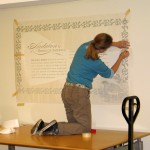 Today we added the final design element to the wall behind the Audubon case. The decorative border (and the bird) came from a source contemporary with Audubon–a book of specimens that a printer would show a client who was looking to publish a book, like sales samples, which we found in the wonderful D. B. Updike collection on printing at the Providence Public Library:
Today we added the final design element to the wall behind the Audubon case. The decorative border (and the bird) came from a source contemporary with Audubon–a book of specimens that a printer would show a client who was looking to publish a book, like sales samples, which we found in the wonderful D. B. Updike collection on printing at the Providence Public Library:
Specimen of Printing Types and Ornaments, from the Type and Stereotype Foundry of William Hagar and Co. (New York: [s.n.], 1841).
Shown here is Melissa, the installer from the sign company (ArtFX).
My fabulous designer, Arley-Rose Torsone, took this little bitty ornament and the bird (which is the size of a quarter), did her magic, and produced a design that the sign company then fabricated into vinyl.
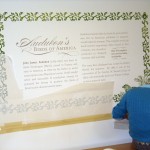 It really pops–the text has a much more finished look, and the frame draws the eye to it.
It really pops–the text has a much more finished look, and the frame draws the eye to it.
Now we just have to get the floor finished, and we’ll be ready to go!
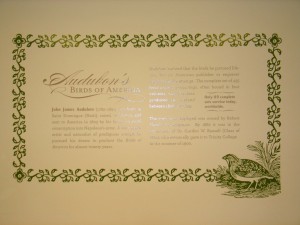
Comments Off on Audubon wall, stage II
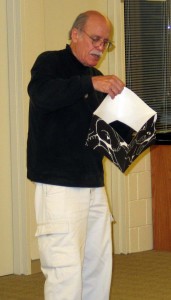 Printmaker and artist Werner Pfeiffer visited the Watkinson last night to speak to students in Erin Valentino’s First Year Seminar on post-9/11 art and Jonathan Elukin’s History of the Book course.
Printmaker and artist Werner Pfeiffer visited the Watkinson last night to speak to students in Erin Valentino’s First Year Seminar on post-9/11 art and Jonathan Elukin’s History of the Book course.
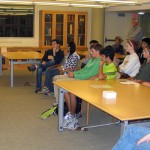 Werner constructed his work entitled “Out of the sky” as he spoke about where he was on 9/11 (crossing a bridge into Manhattan–he saw the second plane hit) and how the project took shape in his mind and through his hands over the next five years.
Werner constructed his work entitled “Out of the sky” as he spoke about where he was on 9/11 (crossing a bridge into Manhattan–he saw the second plane hit) and how the project took shape in his mind and through his hands over the next five years.
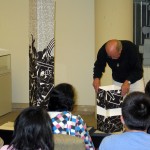 The towers, depicting names of the the victims and images of falling bodies, girders, and steps, are made up of 36 prints carved into 18 blocks of wood–blocks that Werner carved himself, a relief process that involves cutting away what one does not wish to see in the print.
The towers, depicting names of the the victims and images of falling bodies, girders, and steps, are made up of 36 prints carved into 18 blocks of wood–blocks that Werner carved himself, a relief process that involves cutting away what one does not wish to see in the print.
The act of building the towers and taking them back down is intended as a kind of birth, life, and death of the memory of the tragedy. You open it up to remember and reflect, and you close it down and put it away to move on.
In a small booklet Werner listed the victims from all four planes and the sites they struck.
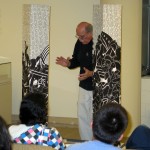
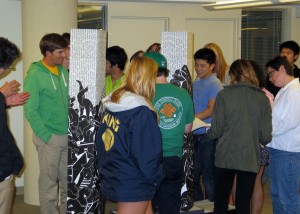 Werner always designs hands-on productions, and he encouraged the students to handle the towers, and even help take them down.
Werner always designs hands-on productions, and he encouraged the students to handle the towers, and even help take them down.
Comments Off on Book Artist @ the Watkinson
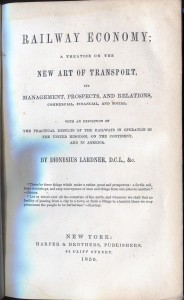 Railway Economy: a treatise on the new art of transport (New York, 1850).
Railway Economy: a treatise on the new art of transport (New York, 1850).
According to the dealer’s description, this is the first edition of possibly the most comprehensive book ever written on railways. The author, Dionysius Lardner (1793-1859) was an Irish-born professor, polymath and prolific writer on astronomy, economics, natural philosophy, and electricity.
Lardner begins with a brief history of transportation through the ages and then focuses on trains, providing many tables and statistics. He leaves out no detail of railway systems in America, Europe, and the U.K., from the cost of building particular lines, to the operation of the boilers, to the behavior of passengers in stations, to the odds of being killed per mile traveled. He concludes with a chapter on the politics of railways, a discussion similar to those of today relating to funding of ownership of roads and the Internet.
Tags: New Acquisition
Comments Off on All Aboard! Newly acquired book on railroads

The night side of nature: or, ghosts and ghost seers, by Catherine Crowe (London, 1852 [3rd edition]). This was the most popular and influential work on paranormal phenomena in the nineteenth century. The author recounts hundreds of “authentic” tales of supernatural occurrences, including premonitory dreams, poltergeists, and döpplegangers, in a passionate plea for scientists to conduct serious investigations into these strange occurrences. She was “a hugely important figure in the emergence of modern ghost-seeing culture chiefly because of her relentless calls for society to turn its attention to the unexplained phenomena in its midst and investigate them in an objective manner.” (McCorristine, Spectres of the Self: Thinking about Ghosts and Ghost-Seeing in England, 1750-1920, p. 10). A sensation in its day, this work introduced many Victorians to the occult, and is considered to have “marked the turning point in society’s relationship with the paranormal.” (Evans, Intrusions: Society and the Paranormal, p. 88).
Crowe (1790-1872), a noted English novelist, was a popular figure who socialized in the same circles as Dickens, Thackery, Hans Christian Anderson, and Charlotte Brontë. She became a celebrity advocate for scientific research into the occult with the publication of The night side, and is credited for introducing the German word poltergeist into the English language with this work (see Blum, p. 15). She was the object of scandal in 1854 when reports circulated that she was found wandering nude and deranged on the streets of Edinburgh—a claim she adamantly denied.
Comments Off on Victorian ghostbuster!
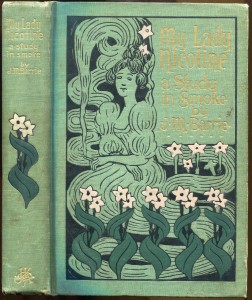 Late 19thC decorative bindings are endlessly fascinating, and this book by J. M. Barrie is even more delightful. This is the first American edition of My Lady Nicotine. A Study in Smoke. In a series of wispy little essays (33 of them, generally under 2,000 words) Barrie explores the pleasures and pitfalls of dedicated smoking recounted by one who has happily married (with tongue lightly in cheek), and has “quit”–but still dreams of bachelor days and the pipe, the cigarette, and the cigar.
Late 19thC decorative bindings are endlessly fascinating, and this book by J. M. Barrie is even more delightful. This is the first American edition of My Lady Nicotine. A Study in Smoke. In a series of wispy little essays (33 of them, generally under 2,000 words) Barrie explores the pleasures and pitfalls of dedicated smoking recounted by one who has happily married (with tongue lightly in cheek), and has “quit”–but still dreams of bachelor days and the pipe, the cigarette, and the cigar.
Illustrated for the first time throughout (well over 130 illustrations in all) by the American impressionist painter Maurice B. Prendergast (only one of two books he illustrated himself).
Chapter titles include, “Matrimony and Smoking Compared,” “His Wife’s Cigars,” “The Romance of a Pipe-Cleaner,” “How Heroes Smoke,” and “The Perils of Not Smoking.”
Tags: New Acquisition
Comments Off on Author of Peter Pan….smokin’!!!
 One of the first things I learned upon starting at the Watkinson was that our copy of the Birds of America, which was given to Trinity by one of its early graduates in 1900 (Dr. Gurdon Russell, Class of 1834), was incomplete. Unfortunately, well before the current security measures were put in place, a professional thief had stolen two plates from the book in 1977. One plate (no. 430, the Slender-billed Guillemot) was recovered from a Boston bookseller within a year of the theft—the man also stole from the Connecticut State Library, the Boston Public Library, the Peabody Institute, and the New Bedford Public Library in Massachusetts. The other plate (431, the American Flamingo), was never recovered. Fortunately, we were able to secure a copy of this plate (from another set, owned by a paper company in Alabama) at auction on September 28, so after 35 years, our set is complete again.
One of the first things I learned upon starting at the Watkinson was that our copy of the Birds of America, which was given to Trinity by one of its early graduates in 1900 (Dr. Gurdon Russell, Class of 1834), was incomplete. Unfortunately, well before the current security measures were put in place, a professional thief had stolen two plates from the book in 1977. One plate (no. 430, the Slender-billed Guillemot) was recovered from a Boston bookseller within a year of the theft—the man also stole from the Connecticut State Library, the Boston Public Library, the Peabody Institute, and the New Bedford Public Library in Massachusetts. The other plate (431, the American Flamingo), was never recovered. Fortunately, we were able to secure a copy of this plate (from another set, owned by a paper company in Alabama) at auction on September 28, so after 35 years, our set is complete again.
















